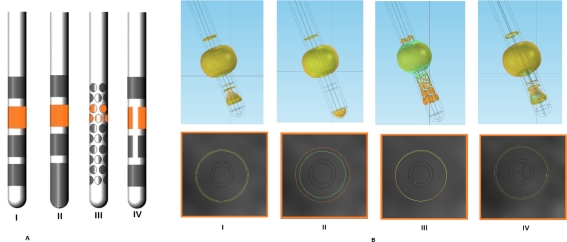Session Information
Date: Monday, June 20, 2016
Session Title: Surgical therapy: Parkinson's disease
Session Time: 12:30pm-2:00pm
Location: Exhibit Hall located in Hall B, Level 2
Objective: To quantitatively compare the spatial extension of the electric field generated by four different lead designs operated under voltage and current modes.
Background: Conventional deep brain stimulation (DBS) leads consist in four cylindrical contacts generating a symmetric stimulation field around the lead. Novel lead designs are capable to steer the stimulation field with semi cylindrical or elliptical contacts. Traditionally DBS systems have operated in voltage mode, but recently current-controlled systems are clinically available.
Methods: The distribution of the electric field (EF) around the leads was simulated using 3D finite element models. Models were set up for four different leads: I) 3389; II) 6148; III) SureStim1; and IV) 6172 Infinity (Fig. 1 A). The model for the brain tissue corresponds to the electrical conductivity for the main brain tissue types, i.e. grey and white matter, cerebrospinal fluid (CSF) and blood. The conductivity values, obtained from the Andreuccetti’s online database [1] were assigned to the segmented T2-weigthed MRI from a Parkinsonian patient [2]. The leads were placed in the Zona incerta (Zi) and the active contacts were set to 1 V or 1 mA. Equivalent contacts (in terms of active surface area) were selected for the steering-field leads. A peri-electrode space was included in the model to consider the tissue-electrode interface after four weeks of leads implantation. The comparison is based on the maximal extension of the EF using an isopotential of 0.2 V/mm [3]. 
Results: The average EF extension from the leads axis was 1.2 ± 0.2 mm for all leads. Current-controlled stimulation presented the largest EF extension. St. Jude lead 6148 showed the maximum EF difference between operating modes (0.64 mm) while Surestim1 the least (0.06 mm). The EF at the cut plane selected was symmetrical for all leads (Fig. 1B).
Conclusions: When equivalent number of active electrodes are selected, steering leads may generate a symmetrical EF as conventional leads. Further investigations at different cut planes are necessary to assess the influence of the tissue heterogeneity on the EF in both operating modes.
To cite this abstract in AMA style:
F. Alonso, N. Göransson, P. Zsgimond, K. Wårdell. Comparison of four DBS lead designs under voltage and current operating modes based on patient specific simulations [abstract]. Mov Disord. 2016; 31 (suppl 2). https://www.mdsabstracts.org/abstract/comparison-of-four-dbs-lead-designs-under-voltage-and-current-operating-modes-based-on-patient-specific-simulations/. Accessed April 26, 2025.« Back to 2016 International Congress
MDS Abstracts - https://www.mdsabstracts.org/abstract/comparison-of-four-dbs-lead-designs-under-voltage-and-current-operating-modes-based-on-patient-specific-simulations/
